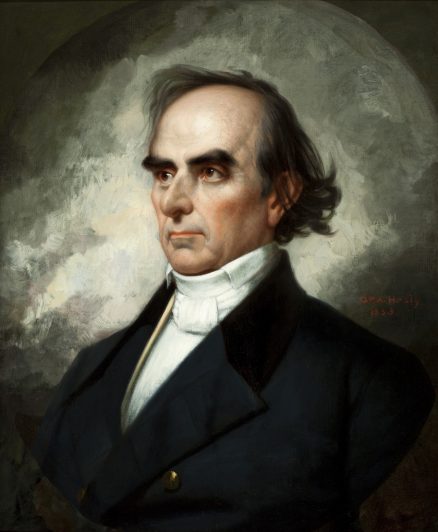- Categories
- Portraits
- Zoom in on Artwork
- Print Page
- Email Page to Friend
It has been said that no man was ever so great as Daniel Webster looked. George P. A. Healy’s portrait of the American statesman fulfills an historian’s description of Webster as “a swarthy Olympian with a craggy face, and eyes that seemed to glow like dull coals under a precipice of brows.”i In Healy’s portrait, the sitter’s level gaze, firmly set mouth, and disheveled hair evoke Webster’s popular image as an inspired orator and an impassioned defender of the Union. His striking features are set off against an undefined background that graduates from dark to light to create a halo around his head. The painted oval indicates the original intention to place the painting in a rectangular frame with an oval liner, a common portrait format in the pre-Civil War period.
In mid-nineteenth century America, painted and sculpted portraits of Webster were prized by individuals and organizations with staunch Union sympathies, such as the Union League of Philadelphia and the Union League Club of Chicago. Powerfully projecting Webster’s forceful character, Healy’s image was widely replicated. The artist himself made some dozen portraits of him, primarily of this type, which others copied. Healy first painted Webster from life in Boston in 1845 on commission from King Louis Philippe of France, as one of a series of likenesses of international statesmen. He then decided to incorporate the portrait into an ambitious history painting depicting Webster’s most famous speech in the U.S. Senate: his defense of the Union in reply to South Carolina senator Robert Hayne’s assertion of individual states’ rights. Completed in 1851, Webster Replying to Hayne was acquired by the City of Boston the following year, just after the death of the revered orator sparked renewed interest in his likeness. For the next several months, Healy was, he reported, “fully employed” in turning out images of Webster based on his widely circulated history painting. The artist charged between two and three hundred dollars apiece for these portraits, of which this is one.ii
Exemplifying Healy’s portraiture, this work combines a solid representation of the sitter with relatively painterly handling of such secondary elements as the coat and the background, where brushstrokes are clearly evident. Healy’s sophisticated style and ability to communicate the individuality of his subjects in flattering likenesses explain much of his enormous success in Chicago, where no European-trained artist had yet settled when he arrived there in 1855.
Wendy Greenhouse, PhD
Donated by M. Christine Schwartz to the National Portrait Gallery, Smithsonian Institution, Washington, DC, in 2021
i Samuel Eliot Morison and Henry Steele Commager, The Growth of the American Republic, v. 1 (New York: Oxford University Press, 1962), 478.
ii Healy quoted in Frederick Voss, “Webster Replying to Hayne: George Healy and the Economics of History Painting,” American Art 15 (Autumn 2001): 50.
